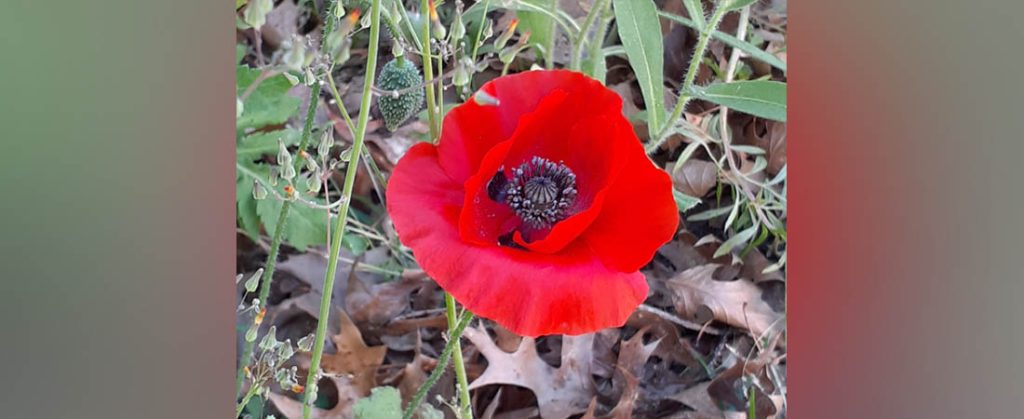
The tradition of honoring the memory of the men and women who lost their lives while serving our country and the tradition of wearing a red poppy evolved over the past 155 years. Originally called Decoration Day, this holiday originated when a group of Southern ladies on May 30, 1866 placed flowers on Union and Confederate graves in Arlington National Cemetery. In 1971, Memorial Day officially became a national holiday as a day to honor and pay respect to Americans who died fighting to defend our freedom in American wars beginning with the American Revolution. The American flag is flown at half-staff until noon and the National Moment of Remembrance asks Americans to pause for a moment of observance at 3 p.m. to reflect and honor those who have given their lives for our country.
The red poppy became a symbol of remembrance that began with the now famous war memorial poem, In Flanders Fields, written during WWI by Canadian, Lt. Col. John McCrae, poet, physician, author, artist and soldier. In Belgium, in the spring of 1915, during the Second Battle of Ypres, he presided over the funeral of fellow soldier and friend, Lieutenant Alexis Helmer, killed in that battle. McCrae’s poem, written from the point of view of the dead and their command to the living to press on, was inspired by the masses of blooming red poppies that surfaced in the displaced bombardment rubble in Flanders Fields, and throughout Belgium and France.
In Flanders Fields, the poppies grow
Between the crosses, row on row,
That mark our place; and in the sky
The larks, still bravely singing, fly
Scarce heard amid the guns below.
We are the dead. Short days ago
We lived, felt dawn, saw sunset glow,
Loved and were loved, and now we lie,
In Flanders fields.
Take up our quarrel with the foe:
To you from failing hands we throw
The torch; be yours to hold it high.
If ye break faith with us who die
We shall not sleep, though poppies grow
In Flanders fields.
When Moina Michael, a University of Georgia professor read his poem, she took a leave of absence to volunteer at the NY YWCA and wrote her own poem, We Shall Keep the Faith, and vowed to always wear a red poppy.
Oh! you who sleep in Flanders Fields,
Sleep sweet – to rise anew!
We caught the torch you threw
And holding high, we keep the Faith
With All who died.
We cherish, too, the Poppy red
That grows on fields where valor led;
It seems to signal to the skies
That blood of heroes never dies,
But lends a lustre to the red
Of the flower that blooms above the dead
In Flanders Fields.
And now the Torch and Poppy Red
We wear in honor of our dead.
Fear not that ye have died for naught;
We’ll teach the lesson that ye wrought
In Flanders Fields.
When the WWI ended, she returned to Georgia with the belief the sale of artificial silk red poppies could generate funds to support returning needy servicemen and women. By the mid-1920’s, the Georgia branch of the American Legion embraced her idea and soon thereafter, the National American Legion approved the red poppy as their official national emblem of remembrance for the fallen.
Before long, the tradition spread to other countries. In Europe, Anna Guerin, a French woman, organized groups of people in her community to sell artificial red poppies to raise money for her war-torn country and soon took her campaign to England. The Royal British Legion embraced this symbol and soon other nations followed suit. However, the red poppy is their official symbol honoring both living veterans and those who died, in the United Kingdom, Canada, France, Belgium, Australia and New Zealand and is commemorated in November on the anniversary of the 1918 Armistice, whereas, in the United States, Americans only wear the “poppy red” over the Memorial Day weekend in remembrance and honor of those whose lives were lost while serving our country.
Today, designated by Congress, National Poppy Day is held the Friday before Memorial Day. Made by veterans as a part of their therapeutic and rehabilitation therapy, handmade red poppies are offered by American Legion members to people throughout their communities for donations that go directly to assist active duty military and veterans with medical and financial needs.
During the Memorial Day weekend, if you are approached by an American Legion veteran, embrace this enduring symbol of remembrance and support the living who have worn our nation’s uniform.
By Susan Moffat-Thomas

